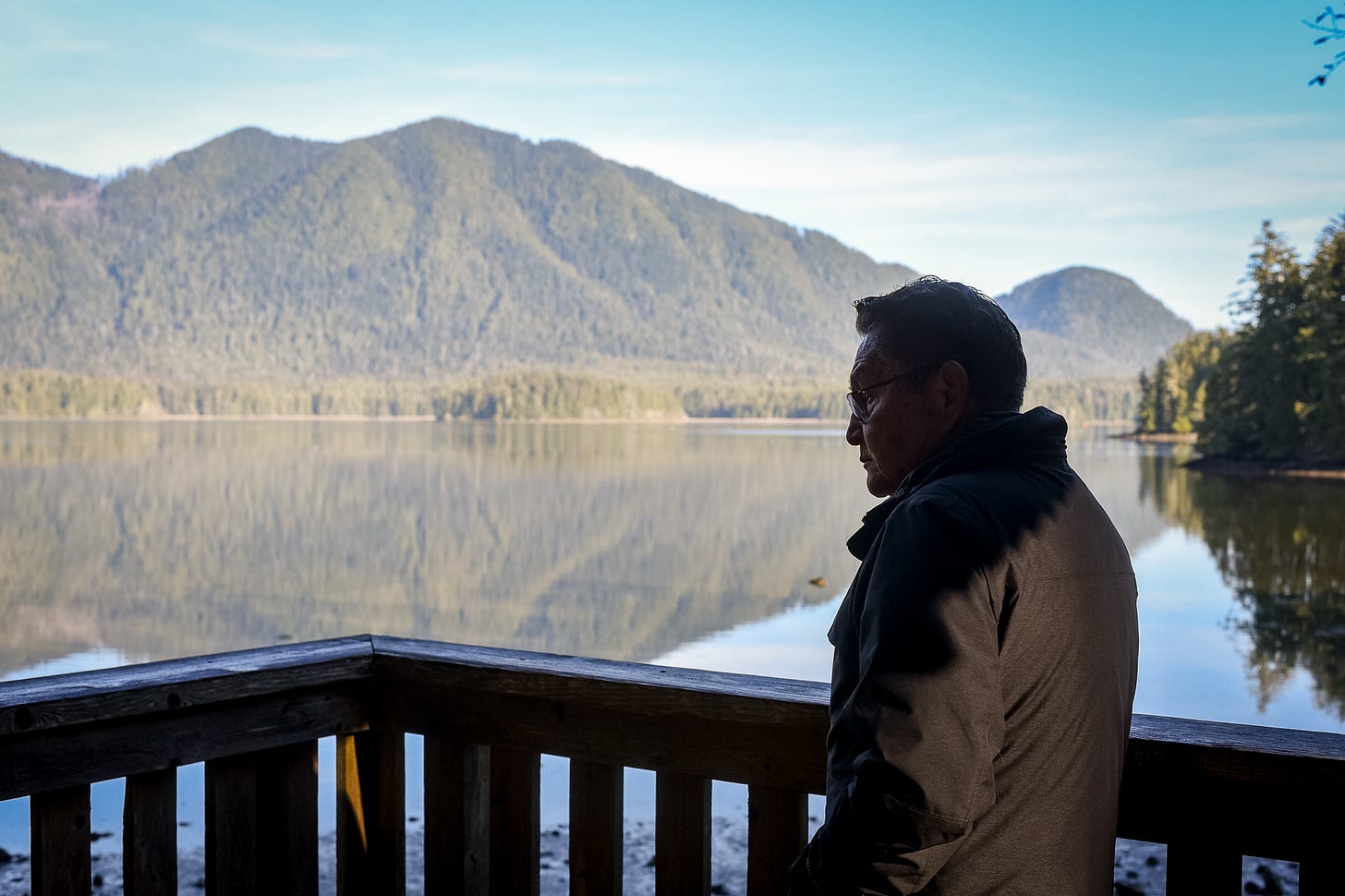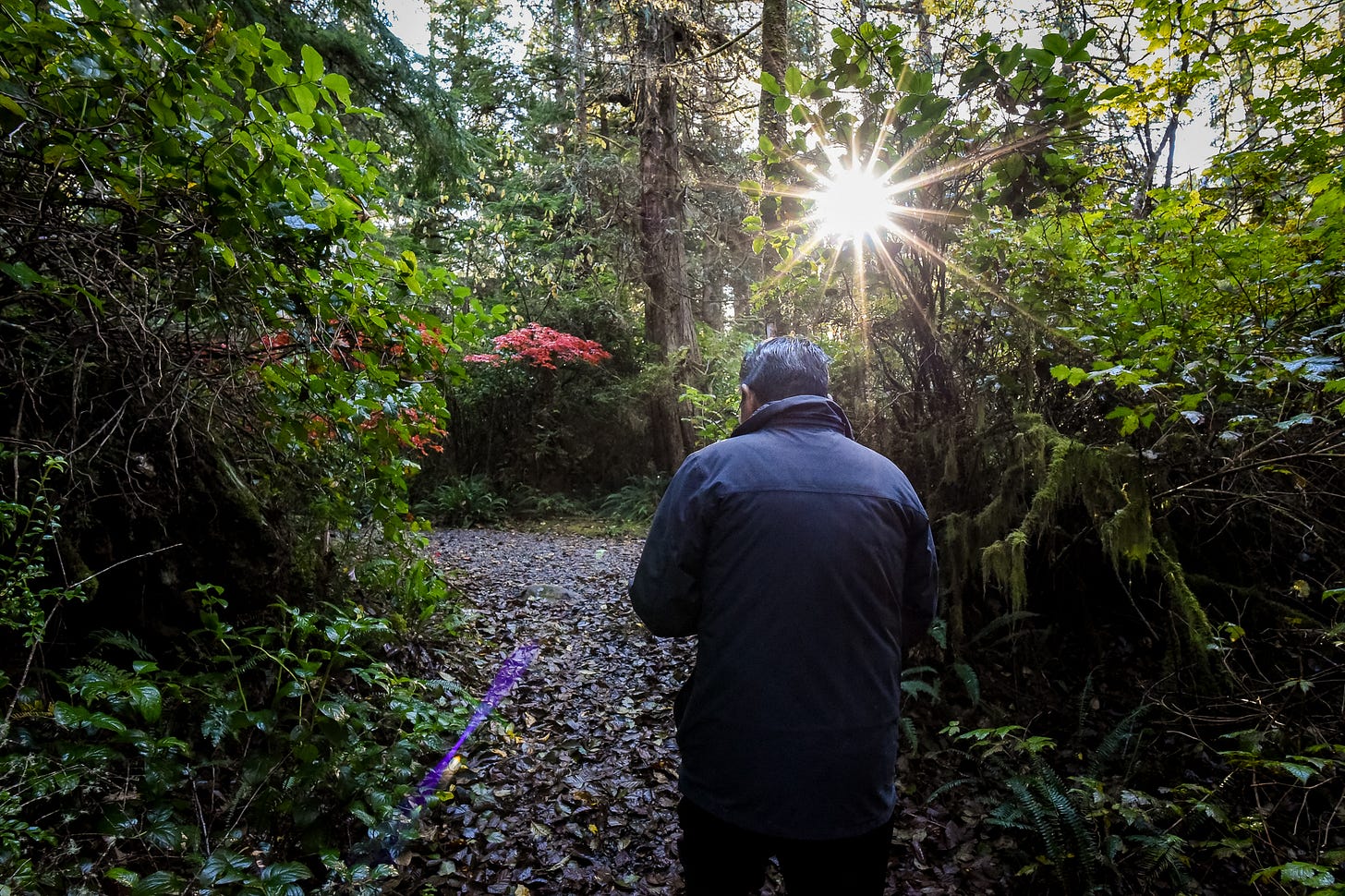Lessons from Vancouver Island's First Nations
"Non-native people aren't going away and neither are we," says elder Moses Martin. Plus, the narcissism of angry young men.
A few months ago I had the privilege of meeting a few different Aboriginal Canadians on the tranquil island of Tofino, located within the traditional territory of the Tla-o-quio-aht First Nations on the west coast of Vancouver Island. One day, we spent an hour touring the Tofino Botanical Gardens with 81-year-old elder Moses Martin. As we walked through the old growth cedars, Martin told me of the importance of the natural elements to his tribe which—prior to the smallpox and tuberculosis epidemics of the late 1800s—was once 10,000 strong.
He told me that when his dad was alive, they would watch the trees falling due to deforestation and his dad would warn him, “we’re on the verge of self-destruction.” This early childhood lesson propelled Martin to become a key figure in the anti-logging movement of the 1980s and 90s that became the 1993 Clayoquot Sound demonstrations, known as the ‘War in the Woods.’ His passion for protecting the trees is what led him to create Clayoquot Wild, an environmentally-conscious tour company focused on sharing First Nations knowledge. Non-Native folks, increasingly concerned about climate change and protecting the environment, should look to the First Nations, who have been doing it all along.
If Martin is the protector of the forest, Stevie Dennis, an Ahousaht member of the Kelsemaht First Nations, is the protector of the sea. He started Naas Foods last year, a seaweed and seafood company that uses traditional methods of working with aquatic life to harvest kelp and regenerate the ocean. Like Martin, he laments about the loss of knowledge among the First Nations community.
He takes us out on his fishing boat on the perfectly still water cradled by forested peaks. In our two hours out on the water, we only come across one boat, that comes over to chat with us. It’s two First Nations men out hunting and they’ve had a successful day so far—12 limp ducks lie on the floor of their boat. One of the men picks up a dead duck with pride. I do whatever I do when I’m uncomfortable—use my camera as a shield between me and the reality in front of me. I’m not a vegetarian, but like most Canadians these days, I’m far removed from my food origins, so seeing a pile of dead ducks makes me squirm.
My discomfort in that moment with the dead duck was not unlike the discomfort I felt on my walk with Martin the day prior when he would stop without explaining what we were looking at—there were so many silences that I felt anxious to fill. Both times, I felt like such a city person; where my life is so sanitized and busy and I have a hard time just being without an agenda.
I always go into scenarios with First Nations people eager to connect out of my guilt for our history of residential schools (Martin spent ages 7-14 in one, and I could tell it was a dark time in his life) and how our country still treats Aboriginals today (Martin tells me substance abuse is still an issue in his community). I end up feeling awkward and uncomfortable when I realize that we are just so different, and I can’t cultivate that connection I long for.
But the lesson I took away from my time in Tofino is that I need to lean into that discomfort (like the affirmation on my recovery bracelet I wear every day—“brave the uncomfortable”) because us non-natives have so much to learn from First Nations people. As Martin tells me, “Non-native people aren’t going away and neither are we. We need to learn to live together and a part of that is education.”
When I get back Toronto, a (presumably) homeless man in Union Station lunges at me yelling, “move out of the way, you stupid fucking bitch.” Was he Aboriginal? No, he was Black. But I don’t think the way our country treats a homeless Black man today (and in turn, how he treats a half-Asian woman like me) is unrelated from our history with First Nations people. I couldn’t help but recall Martin talking about how we need to learn to live together. And that starts with leaning into, rather than pulling away from, the discomfort that arises when we feel what makes us different.
Best,
Anna
PS—After two and a half years of offering Best, for free (I know I can’t believe it’s been that long either!), I’ve finally decided to paywall a portion of my newsletter. A few of you have pledged to pay without me asking, and the generous act of validation made me realize how little I value my work. I do believe writing should be accessible to everyone and I care more about getting the story out there than making money, but I also know that it’s important to value my time and energy.
As a woman (semi of colour) with imposter syndrome, I often feel so lucky to even get my foot in the door, but when I signal to others that my labor should be free, it drives down the value of journalism for everyone. I’ve seen this especially with photography, where the rise of exceptional phone camera technology and influencers providing images for free has driven down the value of a skill I paid thousands of dollars to learn.
A yearly subscription costs $2.50 USD a month ($30 USD for the year) or you can opt for a monthly subscription which is $5 USD a month. I want to make it less but unfortunately Substack has set these amounts as the minimum. I know there is little incentive to upgrade to paid when you’ve been receiving this weekly newsletter for free. I will continue to send out a portion of the newsletter with open access but if you feel you get anything from reading Best, I hope you’ll consider upgrading to paid.
As they say—it’s less than the cost of buying a latte once a month!
Published 📝
Forbes - How Pacific Sands Beach Resort Makes Tofino A Wellness Destination Year-Round
Even before I published this article, I kept getting ads for Pacific Sands Beach Resort. The algorithm knows me well, because this resort embodies everything I want a vacation. The 41-plus acre resort occupies 1,500 feet of undeveloped coastline on the crescent beachfront of Cox Bay, with modern suites set in the forest overlooking the ocean. The local Sister Surf school, Tuff City Sauna and By The Sea Massage & Bodywork are all located onsite, which is convenient for a wellness-fiend like me who doesn’t drive. With the focus on the outdoors and the homey feel (they even have a giant DVD library so you can make use of the DVD player in your room!) might be the most Canadian resort I’ve ever visited.
Reading 📖
👫 Practical ideas on how you can contribute to your community.









